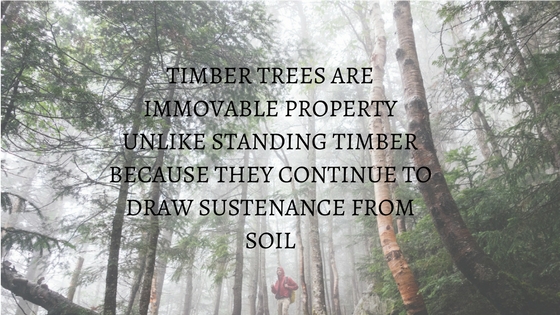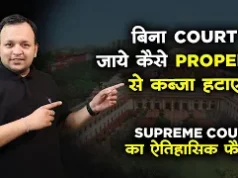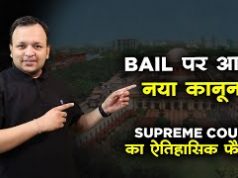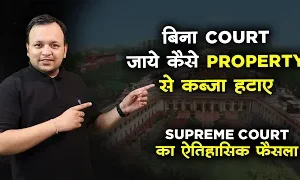
Aapka Consultant Judgment Series- In this series, we are providing case analysis of Landmark Judgments of Hon’ble Supreme Court of India.
Shantabai vs. State of Bombay and Ors.
AIR1958SC532, [1959]1SCR265
Hon’ble Judges/Coram: Sudhi Ranjan Das, C.J., A.K. Sarkar, S.K. Das, T.L. Venkatarama Aiyyar and Vivian Bose, JJ.
Date of Decision: 24.03.1958
FACTS:-
This is a writ petition under Art. 32 of the Constitution in which petitioner claims that her fundamental right to cut and collect timber in the forests in question has been infringed. The petitioner prays for setting aside the order made by the respondent No. 3 on March 19, 1956, directing the petitioner to stop the cutting of forest wood and for a writ, order or direction to the respondents not to interfere in any manner whatever with the rights of the petitioner to enter the forests, appoint her agents, obtain renewal passes, manufacture charcoal and to exercise other rights mentioned in the petition. The petitioner’s husband on April 26, 1948, executed an unregistered document, that called itself a lease, in favour of his wife, the petitioner. The term of the deed is from April 26, 1948 to December 26, 1960, and the consideration is Rs. 26,000. With the passing of the Madhya Pradesh Abolition of Proprietary Rights (Estates, Mahals, Alienated Lands) Act, 1950, all proprietary rights in land vested in the State under S. 3 of that Act and the petitioner could no longer cut any wood. She applied to the Deputy Commissioner and obtained from him an order under s. 6(2) of the Act permitting her to work the forest and started cutting the trees. The Divisional Forest Officer took action against her and passed an order directing that her name might be cancelled and the cut materials forfeited. She moved the State Government against this order but to no effect. Thereafter she applied to this Court under Art. 32 of the Constitution and contended that the order of Forest Officer infringed her fundamental rights under Arts. 19(1)(f) and 19(1)(g).
ISSUE:-
Whether the document in question confers any proprietary rights or interest on the petitioner? To answer this issue, the question which arises is whether trees that will continue to draw sustenance from soil of the land will be included in movable or immovable property?
JUDGMENT:-
In Court’s opinion, the document only confers a right to enter on the lands in order to cut down certain kinds of trees and carry away the wood. To that extent the matter is covered by the decision in Chhotabhai Jethabhai Patel & Co. v. The State of Madhya Pradesh [1953]4SCR476, and by the later decision in Ananda Behera v. The State of Orissa [1955]2SCR919, where it was held that a transaction of this kind amounts to a licence to enter on the land coupled with a grant to cut certain trees on it and carry away the wood. In England it is a profit a prendre because it is a grant of the produce of the soil “like grass, or turves or trees”. It is not a “transfer of a right to enjoy the Immovable property” itself (section 105 of the Transfer of Property Act), but a grant of a right to enter upon the land and take away a part of the produce of the soil from it. In a lease paying services like Calgary property management fees and other expenses, one enjoys the property but has no right to take it away. In a profit a prendre one has a licence to enter on the land, not for the purpose of enjoying it, but for removing something from it, namely, a part of the produce of the soil.
The Court observes that to bring the claim under Art. 19(1)(f) or Art. 31(1) something more must be disclosed, namely, a right to property of which one is the owner or in which one has an interest apart from a purely contractual right. Therefore, the claim founded in contract simpliciter disappears. But, in so far as it is founded either on the licence, or on the grant, the question turns on whether this is a grant of moveable or immovable property. Following the decision in Ananda Behera’s case, Court would hold that a right to enter on land for the purpose of cutting and carrying away timber standing on it is a benefit that arises out of land. There is no difference there between the English and the Indian law. But that still leaves the question whether this is moveable or Immovable property.
Under section 3(26) of the General Clauses Act, it would be regarded as “immovable property” because it is a benefit that arises out of the land and also because trees are attached to the earth. On the other hand, the Transfer of Property Act says in section 3 that standing timber is not Immovable property for the purposes of that Act and so does section 2(6) of the Registration Act. The question is which of these two definitions is to prevail. Now it will be observed that “trees” are regarded as Immovable property because they are attached to or rooted in the earth. Section 2(6) of the Registration Act expressly says so and, though the Transfer of Property Act does not define Immovable property beyond saying that it does not include “standing timber, growing crops or grass”, trees attached to earth (except standing timber) are immovable property, even under the Transfer of Property Act, because of section 3(26) of the General Clauses Act. It is to be noted that the exclusion is only of “standing timber” and not of “timber trees”. In the absence of a special definition, the general definition must prevail. Therefore, trees (except standing timber) are Immovable property.
According to Webster’s Collegiate Dictionary Timber is well enough known to be “wood suitable for building houses, bridges, ships etc., whether on the tree or cut and seasoned“. Therefore, “standing timber” must be a tree that is in a state fit for these purposes and, further, a tree that is meant to be converted into timber so shortly that it can already be looked upon as timber for all practical purposes even though it is still standing. If not, it is still a tree because, unlike timber, it will continue to draw sustenance from the soil.
HELD:-
By applying the principles as laid above, the result is that, though such trees as can be regarded as standing timber at the date of the document, both because of their size and girth and also because of the intention to fell at an early date, would be moveable property for the purposes of the Transfer of Property and Registration Acts, the remaining trees that are also covered by the grant will be Immovable property, and as the total value is Rs. 26,000, the deed requires registration. Being unregistered, it passes no title or interest and, therefore, as in Ananda Behera’s case, the petitioner has no fundamental right which she can enforce.
To Get Legal Opinion from Advocates/ Legal Experts, Please click here
To Get Legal Opinion from Retired Hon’ble Judges, Please click here











